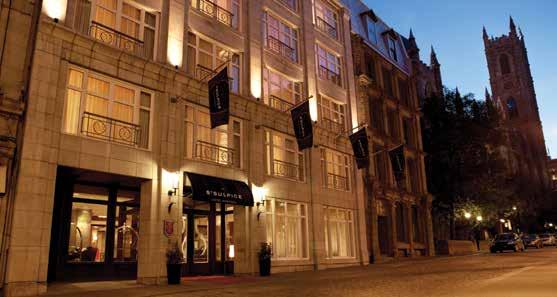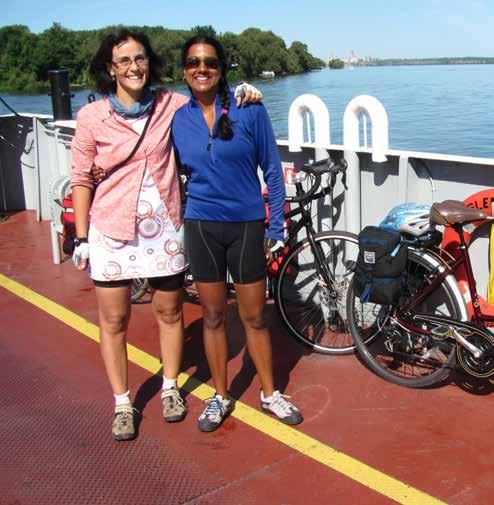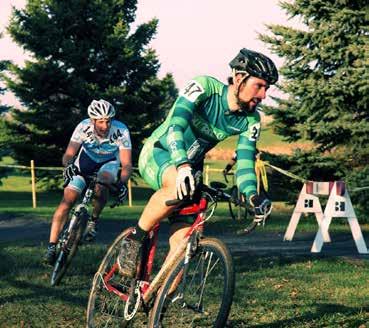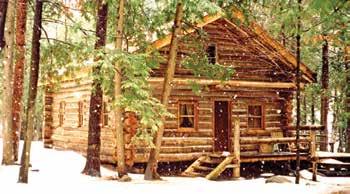
23 minute read
Hiking the Rideau Trail
13-day Rideau Trail hike an ‘OktoberQuest’
WEBSITE HOST RECHARGED HIS LIFE
Advertisement
BY SHEILA ASCROFT
Backpacking the Rideau Trail end-toend in 13 days “almost killed me … yet it gave me new life,” says Bruce Watts. The trail between Ottawa and Kingston is just over 326 kilometres, and Watts is in a good position to assess it.
He got his first tent from his grandfather when he was five. “I’ve been hooked ever since … I’ve camped in every Canadian province and territory less Saskatchewan and Alberta, and covered much of the Adirondacks and Appalachians.”
A retired Ottawa police officer, Watts is the creator of campology.ca, an online magazine, and while on the trail last fall, he posted a video diary of each day on the website; it makes hiking the Rideau Trail come alive.
He says his adventure – he calls it “my OktoberQuest” – was “a profound personal challenge, yet extremely rewarding,” and he’s planning more. In the remaining months of 2013 he’ll hike the Chilkoot Trail with his wife, Tracy, paddle the Yukon River with buddies, and complete the Ottawa/Temiskaming Highland Trail.
Watts, 54, says the “real world” out on the trail is far more
PHOTO BY DOUG HARVEY
interesting than the “pretend world” of YouTube videos and the banalities of television. Camping memories are locked in the brain and “can never be lost during the next computer server crash!”
He’d been thinking about “through hiking” the Rideau Trail for years, but life kept getting in the way. Work, family, doctor’s visits, you know the deal. However, when he became a full-time “campologist” these obstacles vanished – kids grown up helped – and the only barrier was his resolve.
So the planning began, with the aim of keeping his backpack under 13½ kilograms, including a small portable studio to record voice and video, and a computer to edit, upload and share his daily video to the Internet.
Here’s his trip.
Day 1: Kingston City Hall to south of Sydenham, 29.1 kilometres covered
Camping spots difficult to find, so I slept on public land just off the K&P trail, a local semi-urban and rural trail which the Rideau Trail hitches a ride on for about 4½ kilometres.
Day 2: Sydenham to Gould Lake. 23.4 km
Spent two or three hours Sydenham’s Trios Restaurant and its excellent public library. Had to recharge batteries before moving on. I underestimated battery life and had cellphone problems.
Day 3: Frontenac Park, 22.7 km
Met up with friend Bob and hiked Frontenac Park. Logistics were tough. He parked his car at the “end” of the park and took a cab to the “beginning” of the park to start our day. Huge $$$ and a wonderful hike. Thanks Bob.
Day 4: Frontenac Park to Bedford Mills
A long, tough 30-km day. Trail diverse, some of it extremely hard. Feet, legs, hips and knees all sore. This was the only part of the trail without cellphone coverage, so I pushed on to call family to say that all was OK. Spent the night on private property with permission of the land owner.
Day 5: Bedford Mills to the Narrows Locks
Another crazy 30-km day. Very fulfilling but I’m exhausted. Thanks to Parks Canada for allowing campers to use the property.
Day 6: Narrows Locks to Murphy’s Point. 16.2 km.
Hiked only a half day. My wife picked me up at Murphy’s Point Provincial Park for a lift to the
Stay warm this with these winter brands
Swix Merrell Marmot Arc’teryx
Patagonia Canada Goose Louis Garneau The North Face












Trailhead Paddle Shack www.trailheadpaddleshack.ca 1960 Scott Street 613-722-4229

Drummond House B&B. After a well-earned rest, the trek will continue. So far, 151.4 km completed.
Day 7: Lally Farm at Murphy’s Point to Perth, 28 km.
Started late and hiked into the night to reach a safe camping stop in Perth. Sore legs, but not too bad.
Day 8: Perth to the Beveridge Locks.
A short, sweet day. Late start after breakfast with friends at a local diner. Thanks to Parks Can ada for being camping-friendly!
Day 9: Beveridge Locks to Smiths Falls.
Stopped early in the rain to avoid Hurricane Sandy. Despite safe choices for camping in Smiths Falls (with expected 90 k/ hr winds), I chose a hotel. Inter view with the Record/EMC news.
Day 10: Smiths Falls to Merrick ville, 32 km.
Back and shoulders are good thanks to my Sierra Design back pack, but swollen, tender and bruised feet. Lots of hiking on gravel today – ouch! The bonus was Wolford House B&B, friendly and accommodating to Rideau Trail hikers, and Rideau Canal paddlers.
Day 11: Merrickville to spooky Marlborough Forest.
Halloween rain, trail under water. The coyotes, and I later learned, wolves howling all night.
Day 12: Marlborough Forest to West Ottawa, 45 km.
A monster of a day ... just want to get home. Lost my titanium spork (spoon/fork) and had to “drink” my spaghetti dinner. Crossed the Jock River three times. Legs feel good though.
Day 13: West Ottawa to the Ot tawa Locks of the Rideau Canal, 16 km.
Done … the whole 326.5 km of the Rideau Trail is complete. Yes! Ouch, my feet! Time for some
CAMPOLOGY ONLINE
After 30 years on the Ottawa Police Force, Watts created campology.ca in 2011 to help people make outdoor adventures safe and comfortable. According to the site, you too can become a “certified campologist.” Watts admits the two “campology” certificate programs are “recognized by no one and nowhere. It may be only for fun – but it isn’t easy.”
The website provides advice for almost anything you might encounter while camping: • checklists for canoe, kayak, bike, car, and on-foot camping • a survivor guide covering everything from a bee sting to a volcanic eruption • a gear section with chances to win free equipment • an eclectic campologist blog • plenty of videos!

Surprenez votre imaginaire Indulge your imagination


414 Saint-Sulpice, Old Montreal 514 288 1000 | 1 877 785 7423 LESAINTSULPICE.COM








THE ULTIMATE GETAWAY WEEKEND
BY KATHLEEN WILKER
Try this for a getaway weekend: bike the shores of Lake Ontario and the Bay of Quinte from Kingston to Prince Edward
County with stops at B&Bs along the way. Add on a wine-tasting tour once you get there. It works. My friend Bonnie (on right) and I went car-free, booking Via Rail tickets from Ottawa to Kingston. It’s a relaxing way to travel, but the absence of baggage cars means you can’t transport a bike unless it’s a folding model. Undeterred, we decided to travel with two small panniers and rent bikes in Kingston. If you’re keen to take the train and your own bike, some trains on the Cornwall to Kingston route have baggage cars. You and your bike just need to get to Cornwall first.

Taking the Greyhound with your bike from Ottawa to Kings ton is doable, but you have to box it for transport in the storage bin. This makes sense on a longer trip, but seemed inconvenient for a weekend get away. Ahoy Rentals on Kingston’s waterfront rented us two stepthrough touring bikes with upright handle bars and a back rack – ask ahead of time for the latter. Neither of us brought bike tools, but we wished we had an Allen key and a small multi-tool for minor adjustments to the seat height. We packed bike shorts and chamois butter in our panniers and were glad to have both, especially with seats we weren’t used to. Biking around Kingston gave us a chance to visit a bakery for lunch, browse the farmers’ market and take in a little of the Town Crier festival that was noisily going on. Then we were ready to follow the Great Waterfront Trail west along the shore of Lake Ontario. For our first day, we planned to ride 30 kilometres Bath. Since we both regularly ride from home up to Champlain Lookout in Gatin eau Park (about 50 kilometres, with gruelling hills), we thought Bath would be an easy start. But a fierce headwind most of the way made us glad the distance wasn’t longer, despite the stunning views of Lake Ontario’s sparkling waters. Having found bike-friendly ac commodation on the Welcome Cyclists network (welcomecy clists.ca/network), we chose the Jubilee Bed and Breakfast, right across Highway 33 from the Am herst Island ferry, just outside Bath. Jackie and Richard Has safrass welcomed us to their B&B atop a cliff that was once a quarry. Walking trails around the property and a horse to ride (if you know how) were a bonus, but our fa vourite part was the ample and delicious breakfast. With arrangements made in advance, the hosts will prepare your dinner – ideal for cyclists too tired to go out to a restau rant. Our hosts suggested a few eating spots in Bath, just “five minutes down the road.” Feeling windblown and wondering if this was five minutes by bike or five minutes by car, we took the ferry to have dinner on Amherst Island instead. Once ashore we strolled off the ferry dock toward nearby Stella’s Café. Though it was only 6:30 p.m., it had just closed, but the host kindly made us grilled cheese sandwiches and fresh cu cumbers from her garden. This café has a fleet of old bikes for visitors to borrow while they’re on the island. The next morning we rode through Bath, taking in its marina, a variety of shops and restau rants on its quiet main street and a large park where a farm pr oduce and craft market was being set up. We were headed towards the Glenora ferry that would set us on the road to Picton in the
heart of Prince Edward County. With no headwind, we cruised easily past wineries and roadside stands offering fresh blueberries and apples.
Before we knew it we were at the ferry, lining up with motor cyclists out for a sunny morning ride across one of the shortest water passages in the province. Riding into Picton with a deli cious lunch ahead of us was a great way to spend the rest of the morning. Once we arrived, we locked our bikes and wandered.
Coffee, bakeries, a farmers’ market, little shops and a book store were all on the agenda. We were so comfortable at the book store that we almost curled up on the comfy chairs for a nap, so it was definitely time to ride on to our B&B. Located about 10 kilome tres from Picton, Jackson’s Falls Country Inn near Milford was a lovely ride on quiet country roads. A converted schoolhouse, this B&B offers a garage for bike storage and steel-cut oats for breakfast porridge along with omelettes, toast and coffee. There’s another bike-friendly feature if you’d rather drive to Prince Edward County and ride after you arrive. The Bloomfield Bicycle Company (bloomfield bicycle.ca) will deliver a bike to Jackson’s Falls for the duration of your stay. After she showed us around, our host Lee Arden Lewis drew us a map of three wineries in the Milford area. After leaving be hind all but one pannier (for the camera and, we hoped, a bottle of wine), we set off. The plan was too ambitious. We could have spent the whole afternoon at Long Dog Winery, chatting with the winemaker and tasting his Pinot Gris, we were having such a great time. Our next stop was Exultet Estates and their ice wine, tasty and in a compact bottle ideal for bike touring. But we were starting to wilt, so we deferred the third winery to our next visit. We took a free shuttle from our B&B into Picton, a service with stops at Waring House or the Claramount Inn and Spa res taurants. It is scheduled to run through to the new year and op erates Friday and Saturday from Jackson’s Falls and other B&B/ Inns in the county.
The next morning the roads were even quieter. We couldn’t leave without some of the county’s famous food, so we stocked up on three-year-old cheddar and local honey at the Black River Cheese Company. This detour took us by Lake of the Mountain – a pristine lake one side of the road with the Bay of Quinte on the other. The lake is at the top of a daunting, long hill after you get off the Glenora ferry, so we saw it only from afar as we rode past, retracing our route to Kingston with a light breeze at our backs. A stop for blueberries at a pick-your-own farm introduced us to their producer. He had been part of a committee 18 years ago which lobbied for a paved bike lane on the Loyalist Pathway towards Bath so cyclists could ride safely. It was a pleasure to thank him for his advocacy. Back in Kingston the Town Crier event was winding down with finalists battling it out by City Hall. We returned our bikes, had an iced coffee and took a taxi back to the train station. It’s a trip we’ll definitely repeat.
LOLE COAT EVENT
FREE GIFT WITH THE PURCHASE OF ANY 2013 LOLE FALL/WINTER COAT – OCTOBER 17-27





YOUR DESTINATION FOR AN ACTIVE LIFESTYLE





5607 Hazeldean Road | Ottawa | 613-831-3604 203 Richmond Road | Ottawa | 613-792-1170
shop online at bushtukah.com
A Cape Breton vacation remembered
A FAMILY ESCAPE TO WHALES, LOBSTERS, MUSEUMS AND THE CABOT TRAIL

BY DAVE BROWN

The anticipation of the family trip to Cape Breton was as thick as the fog we sometimes drove through. Truly a summer of adventure I hope we can repeat someday.
It began with our son's first airplane ride, and graduated to many other firsts. His first rescue of jellyfish (under the supervision of lifeguards); his first visit to the Atlantic Ocean and his first sixth birthday whalewatching with Captain Mark's and more than 25 pilot whales. His laughter was infectious.
Our accommodations were shared between two locations. The longest stay (our home away from home) was at the Cape Breton Resorts at Kildare Landing in Baddeck. We also stayed one night at the MidTrail Motel & Inn in Pleasant Bay, and it was cozy and close to whales.
Activities varied from visiting the Alexander Graham Bell museum; driving to the ocean; feasting on lobster each night at the family-friendly Bell-Buoy Restaurant and enjoying the music; and visiting the local beach and shops.
When you’re ready to head to the east coast, check out the same spots – you’ll be glad you did.

Photos (clockwise): Mother and son cozy at the Ottawa airport; whalewatching with Captain Mark's; just part of the huge Bras d'Or Lake in Baddeck; an amazing sunset in Pleasant Bay; and our resident jellyfish rescuer.


Cabot Trail Pleasant Bay Cape Breton Nova Scotia

1-800-215-0411 www.midtrail.com

Call: 1-888-754-5112

Email: captain@whaleandsealcruise.com Website: www. whaleandsealcruise.com
CYCLOCROSS RACING DIRTY BUT FUN
BY SHEILA ASCROFT
“Cyclocross sucks! It’s all about pain, suffering, and self-loathing. I love it,” says Matt Surch, team rider, event organizer, and blogger for Tall Tree Cycles Bike Shop in Westboro, Ottawa.
For some, like Matt, cyclocross is a great way to enjoy the stunning fall colours and to get through the dreary cold rains before the snow falls. The consummate cyclist, Matt rides/races in every season: fat bikes in winter, cyclocross in the spring, and fall, mountain bikes once the trails are dry, and road bikes in summer.
SO WHAT IS CYCLOCROSS?
It’s a hybrid event, combining the intensity of both road racing and mountain bike racing with bouts of running over varied terrain. It is a one-hour, multi-lap event where you ride your bike along a marked route that goes over pavement, gravel, grass, dirt (mud), hill and dale and everything in between! Oh, and there are intentional on-route obstacles that require you to dismount, shoulder your bike, run over the barrier, remount and ride on – over and over again. “The changes in tempo make for very intense racing – thankfully, it’s for only an hour!” says Matt.Cyclocross began in Europe in the early 1900s as a way to stay fit during the off-season for pro cyclists, and developed its own specialized following. It’s been growing in popularity in North America over the last decade, and has an active component in our neck of the woods too. The Eastern Ontario Cyclocross Series, which has run for over 20 years, offers a 10-week season from the last Sunday of September through to the last Sunday of November or first Sunday in December. The mass-start races (9 a.m. and 10:30 a.m.) follow a three- to five-kilometre circuit over varied terrain. Each lap is timed and whoever finishes the most laps within one hour wins. Points are awarded to finishers and are accumulated over the series.
WHY DO IT?
It’s fun. Honest. Ask Matt. “Well, it’s fun if you like getting muddy and gritty, and sweaty while riding at a furious pace in near freezing weather.” It’s fun if you like to ride then run with your bike on your shoulder over obstacles and then ride again – all on varied train again and again. “It’s good for you too! It’s addictive, because every race is an opportunity to improve in a thousand ways. Small improvements, repeated many times over the course of a race, add up, and encourage racers like me to keep learning.” Cyclocross is a great way to stay in shape during the dreary fall months, and the bike handling skills developed and honed at the races translate into safer riding out on the roads and trails. Perhaps most importantly, Matt says that, “cyclocross is about community. No matter the ability level, every rider faces the same challenges, the same internal battles: ‘Can I push harder to stay on that wheel?’ ‘Should I?’ The challenge of each race, each struggle, bonds riders together. Blood, sweat, and gears.” (For more reasons, see www.cxmagazine.com)



DO I NEED A CYCLOCROSS BIKE?
Obviously, having a cyclocrossspecific bike is best – but it is not mandatory.
CYCLOCROSS BIKE
Essentially it looks similar to a road bike but the lightweight frame and some of the components are
designed for cross racing. A ‘cross’ or ‘CX’ bike has the traditional drop bars and 700c wheels (24” for small riders), but uses cantilever brakes, or even disc brakes, for better stop ping power and, perhaps more importantly, the maximum mud clearance possible. The frame also has widely spaced seat stays and forks, which gives additional clear ance for wide, knobby tires and allows mud-covered tires to spin freely without jamming. The tires have tread patterns that throw off dirt and mud, while offering low rolling resistance on pavement. Many racers use traditional ‘tubular’ tires, which are glued to the rim, to allow for the use of lower tire pres sures without risk of rolling a tire off the rim in a turn.
Another difference is that the frame’s bottom bracket (where the crankset is mounted) is higher for additional clearance over obstacles and for pedalling around corners. The gearing is usually easier than on traditional road bikes too. Per sonal preference can see outer chainrings of 44- to 50-teeth and 38- or 39-tooth inners. The rear cassette is typically 11-28 tooth cogs. Most competitors use dualsided mountain-bike clipless pedals for cross racing. They’re easy to enter and exit, shed mud well, and work with off-road shoes with toe spikes mounted, which are best for running, especially up muddy banks.
MOUNTAIN BIKE
Many riders convert their offroad bikes for amateur cyclocross racing. To be safe (and to lighten the bike since you’ll be lifting it often!) remove the bar-ends on your handlebars; take off the frame pump, seatbag and water-bottle cages. These are unnecessary and only weigh you down. Re place current tires with 1.25- or 1.5-inch-wide ones as these are easier to pedal and faster than fat ter knobbies. Plus, narrow tires cut through mud better and offer more clearance on wet race days. You can also save weight and improve efficiency by removing your front shock and installing a rigid fork. Suspension is not necessary for cross because courses are fairly smooth.
ROAD BIKE
Be forewarned: this type of bike will only work well in dry condi tions. On muddy courses, the brakes and stays will clog with mud, jam the wheels and force you to run the entire race or drop out.

That ain’t no fun! Still, if you only have a roadie, try changing out your narrow tires for wider knobby ones if there is room then, take off all the excess stuff (seatbag, wa ter bottle cages, etc.) and modify the gearing. If you can replace your road pedals with some kind of dual-sided mountain bike clip less pedals – all the better. These are easier to clip into and shed mud better than road pedals, and you’ll be able to wear your off-road shoes which are much better for running. Keep in mind that cross racing is very hard on equipment. You might end up with some new paint chips or broken component or even a bent wheel.
What’s in the pit?
While road racers are supported by a team car or teammates if they have mechanical problems, mountain bike racers are usually entirely self-sufficient. Cyclocross, like everything else, offers a compromise of the two. Cyclocross courses have a pit, where riders can exchange bikes/wheels (assuming they have spares!) when theirs are unrideable because of damage or excessive mud buildup. Most local racers bring spare wheels in the event of a puncture during warm-up on course, and in case they puncture close to the pit, while the pros may have two or three spare bikes. In a complete mud fest (think November chilly rains), some pros might actually exchange bikes every lap!
WHY THE RUNNING?
Running and carrying your bike on your shoulder adds both physical complexity (it’s a skill to properly dismount the bike while rolling, carry it, then remount), and a unique element to your average bike ride. Running sections are of ten flat, featuring man-made barriers. Other times, they are natural elements: short, steep and difficult. Matt says that Knowing when to run can change the race,outcome; particularly because of the repeat ability (most races entail 5-10 laps). Running with your bike may be faster than trying to ride through a muddy section where you would bog down.
“This tactical element to racing increases the fun-factor for racers, since it offers the opportunity to see gains from making clever deci sions. Being wily can allow riders to excel in relation to others who are fitteg. This is also an example of risk-takin, that can pay dividends, which is another reason why cy clocross keeps riders coming back for more.”
For information about the East ern Ontario Cyclocross Series, visit www.cyclocross.org.
860 Bank St. (613) 231-6331 www.glebetrotters.com



FOR THE PLACES YOU’LL GO.
Revive the heart of your home!



60A Colonnade Road, Ottawa, Ontario K2E 7J6

In a cozy atmosphere, the outdoor enthusiast can choose from swimming, tennis, hiking, cycling and a plethora of other activities terrific for the entire family or for a romantic weekend away. Sit by the famous towering six-sided stone fireplace where you can relax with a nice book, game or conversation. Only 45-min away, it's truly magical! Visit their website at: www.fairmont.com/montebello

_LCF_ottawa_Layout 1 13-08-15 12:53 Page 1
Your dream vacation. Your next ski trip. Your early retirement.
All depend on one thing.
your next move. maDeLYn CoCHrane mBa Consultant Are You Ready? (613) 723-7200 We can help. madelyn.cochrane@ investorsgroup.com Ask about THE PLAN 2 Gurdwara road Suite 500 nepean, on K2e 1a2
From $ 129 From $ 139
*Sunday to Thursday
*Friday and Saturday
* Per night, per room, in double occupancy. Accomodation in a
Fairmont room. Subject to availability from Nov. 1 to 30 2013. ** Please note that culinary workshops will be conducted in French only.
getaway in november

Start Christmas in November and take advantage of our Christmas in November activities, from November 1 to 30. Majestic Christmas decorations, culinary workshops**, culinary demonstrations, a visit from Santa Claus and much more! Stuart Log Cottage Ideally located within the walls of Old Québec, this heritage urban resort is only 20 minutes from the Québec City airport and 5 minutes from the Via train station. Treat yourself to Québec City’s “joie de vivre”!
1 800 441-1414 • fairmont.com/frontenac-quebec
Traditional cabin for rent in the Ottawa Valley • spacious living room with large stone fireplace • large loft bedroom suitable for family • 4 piece bath with tub and shower • full kitchen with fridge, stove • private dock on Mink Lake www.StuartLogCottage.com (613) 628-3311 For more inFo pLeaSe CaLL











